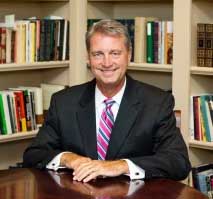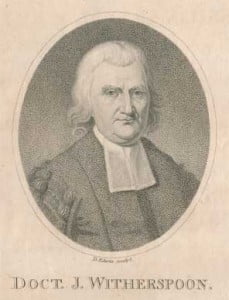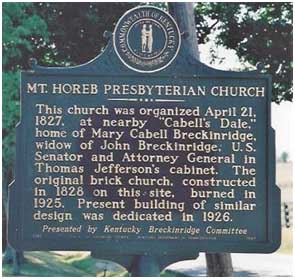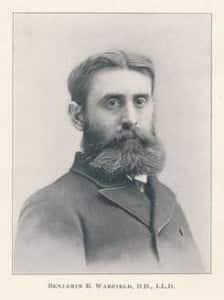 Our good friend and guest author, Rev. David W. Hall, returns today with another installment in our Election Day Sermon Series. Today’s post concerns a sermon by the Rev. John Witherspoon [1723-1794], a noted Presbyterian pastor who had the unique distinction of being intimately involved in the formation of both the United States government and the establishment of the first General Assembly of the Presbyterian Church in the U.S.A. Witherspoon rightly can be spoken of as a founding father of both institutions. He was a delegate from New Jersey to the Second Continental Congress (May 5, 1775) and was one of the signers of the Declaration of Independence (July 4, 1776). Later, in May of 1789, he served as the convening moderator for the first General Assembly of the Presbyterian Church in the U.S.A
Our good friend and guest author, Rev. David W. Hall, returns today with another installment in our Election Day Sermon Series. Today’s post concerns a sermon by the Rev. John Witherspoon [1723-1794], a noted Presbyterian pastor who had the unique distinction of being intimately involved in the formation of both the United States government and the establishment of the first General Assembly of the Presbyterian Church in the U.S.A. Witherspoon rightly can be spoken of as a founding father of both institutions. He was a delegate from New Jersey to the Second Continental Congress (May 5, 1775) and was one of the signers of the Declaration of Independence (July 4, 1776). Later, in May of 1789, he served as the convening moderator for the first General Assembly of the Presbyterian Church in the U.S.A
“The Dominion of Providence Over the Passions of Men”
by John Witherspoon (May 17, 1776)
 John Witherspoon (1723-1794) emigrated to America in 1768 to become the sixth president of the College of New Jersey after Samuel Finley’s death. According to James Smylie, Witherspoon was “embroiled in American politics almost immediately upon disembarking.”[1] His Princeton, which later officially embraced Westminster Calvinism, became a clinic for republican ideas; it was perhaps as important for the transmission of Calvinistic ideas into the America of the eighteenth century as Harvard had been in the seventeenth.
John Witherspoon (1723-1794) emigrated to America in 1768 to become the sixth president of the College of New Jersey after Samuel Finley’s death. According to James Smylie, Witherspoon was “embroiled in American politics almost immediately upon disembarking.”[1] His Princeton, which later officially embraced Westminster Calvinism, became a clinic for republican ideas; it was perhaps as important for the transmission of Calvinistic ideas into the America of the eighteenth century as Harvard had been in the seventeenth.
Witherspoon’s republican views had a decisive influence on James Madison and other founding fathers. After graduation in 1771, Madison was torn as to whether to pursue a career in law or the ministry, and he spent an additional year reading moral philosophy, Hebrew, and theology under Witherspoon.[2] His days at the College of New Jersey led him to cross paths with many of the patriots who would lead America to independence. Evaluating Witherspoon’s role in heating up American patriots, L. H. Butterfield infers that, “the ties between Presbyterians in Scotland and America just before the Revolution are shown to be even firmer and more intimate than had been realized.”[3]
Reared in a Scottish Calvinistic home in Gifford, East Lothian, he apparently came to love the teachings of the Genevan Reformer. His mother, a descendent of John Knox, had him reading the Bible at age four, and he was catechized in the Westminster Confession.[4] His father was a minister who constantly read the sermons of earlier French Huguenot and Calvinist ministers.[5] Preserving the tradition of his Scottish forebears, he warned against trusting in human prowess. Such Reformation beliefs would become more widely known in America because According to Scotland-born Benjamin Rush, a signer of the Declaration of Independence, he exceeded any preacher in Scotland: “Indeed I have heard few preachers in the course of my life that were equal to him. . . . His sermons are loaded with good sense” and elegance.[6] His fiery and articulate preaching moved many towards the Revolution. One contemporary promised that from his Princeton post, no one would “have it more in his power to advance the Cause of Christian Liberty by forming the Minds of Youth . . .”[7]
The sermons and discussions from 1760 to 1775 reveal the formative impact of Huguenot ideals on the American Revolution. Upon arrival, Witherspoon immediately inhaled the exhilarating air of American resistance and rapidly became a major public figure. In July 1774, colonial delegates met to seek New Jersey’s independence. Although Witherspoon was not present in person, following that meeting he published his first American essay, Thoughts on American Liberty. In it, Witherspoon called for a congress to hold the people together, stating that self-defense was appropriate.[8] En route to the Continental Congress that same year, John Adams spent several days in Princeton, having dinner with President Witherspoon and attending church where he “heard Dr. Witherspoon all day. A clear and sensible preacher [though] the scholars [students] sang as badly as the Presbyterians at New York.”[9] Meeting privately with Adams, Witherspoon assured him that the Princeton students were all “sons of liberty.”
Like Calvin before him, Witherspoon believed in human depravity, tracing sinful nature of all humans to the fall of Adam, the covenantal (federal) head of the human race. Adam’s fall led to corruption in the human race that required restrictions on both the governed and the governors. According to Witherspoon, whose theology differed little from that of early Plymouth and Massachusetts Bay preachers and governors, the scriptural texts taught that not “one man, or a few men . . . but all without exception” are fallen.[10] In his “Lectures on Divinity,” Witherspoon noted, “What is the history of the world but the history of human guilt? And do not children from the first dawn of reason show that they are wise to do evil, but to do good they have no knowledge.”[11]
The political task, for Witherspoon (and later it seems for Madison) was to “tame the savage” and “restrain the profligate . . . to bridle the fury of human inclination, and hinder one man from making a prey of another.” Madison would later refer to this as the “political depravity of man.” Smylie recognizes that Madison sought “a constitutional system which would qualify all human pretension to power—private and public, civil and ecclesiastical—because of human nature.” [12]
The Continental Congress formed its Articles of Association (note the continuity of Althusian “association”), and meanwhile in New Jersey, committees of correspondence called for a “General Assembly,” a name with roots in Witherspoon’s Scottish Presbyterianism and Genevan republicanism. When a congress of New Jerseyans met in Trenton in May of 1775, nine of the nineteen delegates from Witherspoon’s county were associated with Princeton, further confirming the strong influence of these Witherspoon Presbyterians.
Witherspoon became an increasingly vocal advocate of American independence, on one occasion absenting himself from a Princeton Board of Trustee’s meeting in order to lobby a group in a local tavern to support the Revolution.[13] However, he was at his rhetorical peak on the designated fast day in May 1776, when he delivered his bold sermon, “The Dominion of Providence over the Passion of Men.”[14] From his Princeton pulpit, he laid out the intellectual and religious matrix of the revolutionary movement and clarified the meaning of the phrase “providence” as the patriots understood it.
In that sermon, he explained that even “the ambition of mistaken princes, the cunning and cruelty of [oppression], and even the inhumanity of brutal soldiers” was part of God’s providence. Even the wrath of man ended up serving God. Witherspoon preached that “Nothing can be more absolutely necessary to true religion, than a clear and full conviction of the sinfulness of our nature and state.”[15] Witherspoon certainly did not believe that the Enlightenment had retired the Genevan doctrine of depravity. Man’s inhumanity to others was a clear proof of “the corruption of our nature.” Others could, he said, “if they please, treat the corruption of our nature as a chimera; for my part, I see it everywhere, and I feel it every day.” Human depravity gave rise to all the disorders of society, including the impending war and violence. The “lust of domination” was violent, universal, and radical.
After grounding his sermon on Calvin’s notion of limited human ability instead of on Rousseau and Paine’s optimism about human nature, Witherspoon taught that regardless of human activity, it was God’s will that counted. Human activity was ineffectual. The “Supreme Ruler” often turned the plans and counsels of rebels onto themselves, as he was doing to the British and had done in the pages of Scripture. He saw God’s providence in the British victory over the Spanish Armada (1588), in his prevention of Oliver Cromwell[16] from sailing to New England, and in the settling of so many Protestant refugees in New England. With such examples from history and Scripture, Witherspoon encouraged his listeners to look to God’s continued expression of his providence.
He concluded by noting that peace often required resistance, declaring: “You are all my witnesses, that this is the first time of my introducing any political subject into the pulpit. At this season, however, it is not only lawful but necessary, and I willingly embrace the opportunity of declaring my opinion without hesitation, that the cause in which America is now in arms, is the cause of justice, of liberty.” He defended the action of the colonies, saying, “The confederacy of the colonies has not been the effect of pride, resentment, or sedition.”[17] He also warned that where civic liberty declined, eventually so did religious liberty. The two, he thought, went hand in hand. Witherspoon later wrote, “There is not a single instance in history in which civil liberty was lost, and religious liberty preserved entire.”[18] He also proclaimed, “He is the best friend to American liberty who is most sincere and active in promoting true and undefiled religion.” His final sentence in this sermon was: “God grant that in America true religion and civil liberty may be inseparable, and that the unjust attempts to destroy the one, may in the issue tend to the support and establishment of both.”
Reviews of his powerful sermon ranged from an English comment (“more piety than politics”) to Scottish charges that Witherspoon had “considerably promoted if not primarily agitated” the unrest; another called him, “Dr. Silverspoon, Preacher of Sedition in America.”[19]
Shortly after delivering this sermon, Witherspoon would join the Third Continental Congress in Philadelphia in time to support Richard Henry Lee and John Adams in calling for independence. As a member of the Continental Congress (1776-1782), Witherspoon signed the Declaration of Independence. Later, Witherspoon also designed the original seals for the Navy and the Treasury Departments.[20] In 1780, he served as a state senator in New Jersey. It was Witherspoon who suggested the printer for Congress’ printing of the Bible (fellow Scottish immigrant and Presbyterian Robert Aitken), and one of his final acts was to write the Thanksgiving Proclamation from Congress in November 1782.[21]
One historian viewed Witherspoon as right for his times, hinting that the moment no longer required a revivalist such as Whitefield, nor did the day demand a deep thinker like Edwards. The times called for a cultured man of affairs, and Witherspoon filled that bill.[22] At Princeton’s proving ground of Calvinistic democracy, his advice to students was, “Govern always but beware of governing too much.”[23] He went so far as to apply the doctrine of separation of powers not only to departments within a particular government, but moreover as applicable between the very forms of government[24] as an argument that governmental form should be mixed (that “one principle may check the other”).
That Witherspoon’s influence bore rich fruit may be seen from the fact that from his quarter-century tenure at Princeton, six of his students served in the Continental Congress, one (Madison) became president, ten held cabinet positions, twelve were governors in a day when there were far fewer governors, 30 became judges, 21 were Senators, and 39 served as U. S. Representatives, with numerous others holding state and county legislative positions.[25] Nine of the 55 participants in the 1787 Constitutional Convention were former Princeton students.
A print copy is available in Ellis Sandoz, Political Sermons of the American Founding Era (Indianapolis: Liberty Fund, 1998). An online version is posted at: http://www.constitution.org/primarysources/witherspoon.html.
By Dr. David W. Hall, Pastor
Midway Presbyterian Church
[1] James H. Smylie, “James Madison, Religion, and the Constitution,” unpublished paper, 3.
[2] Merrill D. Peterson, ed., James Madison: A Biography in His Own Words (New York: Harper and Row, 1974), 22.
[3] L. H. Butterfield, ed., John Witherspoon Comes to America: A Documentary Account Based Largely on New Materials (Princeton, NJ: Princeton University Library, 1953), xii.
[4] James H. Nichols suggests that Witherspoon selectively borrowed from Lockean notions. (James H. Nichols, “John Witherspoon on Church and State,” Calvinism and the Political Order, George L. Hunt, ed. (Philadelphia: Westminster Press, 1965), 132.) What this and other similar notes fail to acknowledge, however, is that Calvinist theorist Johannes Althusius structured his entire political scheme around “association” as early as 1603.
[5] Martha Lou Stohlman, John Witherspoon: Parson, Politician, Patriot (Philadelphia: Westminster Press, 1976), 17.
[6] L. H. Butterfield, ed., John Witherspoon Comes to America: A Documentary Account Based Largely on New Materials (Princeton, NJ: Princeton University Library, 1953), 34.
[7] L. H. Butterfield, ed., John Witherspoon Comes to America: A Documentary Account Based Largely on New Materials (Princeton, NJ: Princeton University Library, 1953), 22.
[8] Martha Lou Stohlman, John Witherspoon: Parson, Politician, Patriot (Philadelphia: Westminster Press, 1976), 99.
[9] Cited Martha Lou Stohlman, John Witherspoon: Parson, Politician, Patriot, 102.
[10] James H. Smylie, “Madison and Witherspoon: Theological Roots of American Political Thought,” The Princeton University Library Chronicle, XXII, 3 (Spring, 1961), 120.
[11] Cited James H. Smylie, “Madison and Witherspoon: Theological Roots of American Political Thought,” 119.
[12] James H. Smylie, “Madison and Witherspoon: Theological Roots of American Political Thought,” The Princeton University Library Chronicle, XXII, 3 (Spring, 1961), 120.
[13] Martha Lou Stohlman, John Witherspoon: Parson, Politician, Patriot (Philadelphia: Westminster Press, 1976), 109.
[14] The references to this sermon are taken from Ellis Sandoz, ed., Political Sermons of the American Founding Era, 1730-1805 (Indianapolis: Liberty Press, 1991), 529-558.
[15] Witherspoon also noted that true religion was revived at the Reformation. Ellis Sandoz, ed., Political Sermons of the American Founding Era, 1730-1805 (Indianapolis: Liberty Press, 1991), 543.
[16] A. W. M’Clure, Lives of the Chief Fathers of New England, vol. 2 (Boston: Massachusetts Sabbath School Society, 1846), 61.
[17] Martha Lou Stohlman, John Witherspoon: Parson, Politician, Patriot (Philadelphia: Westminster Press, 1976), 112.
[18] Witherspoon, Works, III, 37, quoted by Sandoz, op. cit., 214.
[19] Martha Lou Stohlman, John Witherspoon: Parson, Politician, Patriot (Philadelphia: Westminster Press, 1976), 115.
[20] Martha Lou Stohlman, John Witherspoon: Parson, Politician, Patriot (Philadelphia: Westminster Press, 1976), 132.
[21] Martha Lou Stohlman, John Witherspoon: Parson, Politician, Patriot (Philadelphia: Westminster Press, 1976), 143. See also James H. Smylie, “America’s Political Covenants, the Bible, and Calvinists,” Journal of Presbyterian History 75:3 (Fall 1997), 153-164.
[22] James Hastings Nichols, “John Witherspoon on Church and State,” Calvinism and the Political Order, 130.
[23] Martha Lou Stohlman, John Witherspoon: Parson, Politician, Patriot (Philadelphia: Westminster Press, 1976), 89.
[24] Notwithstanding, Witherspoon decried “pure democracy” as excessive and as “subject to caprice and the madness of popular rage.”
[25] James H. Smylie, “James Madison, Religion, and the Constitution,” unpublished paper, 7. Stohlman lists thirteen governors, three Supreme Court judges, 20 U. S. Senators, 33 U. S. Representatives, one Vice President (Burr), and one President (Madison). Stohlman, op. cit., 172

 Our good friend and guest author, Rev. David W. Hall, returns today with another installment in our Election Day Sermon Series. Today’s post concerns a sermon by the Rev. John Witherspoon [1723-1794], a noted Presbyterian pastor who had the unique distinction of being intimately involved in the formation of both the United States government and the establishment of the first General Assembly of the Presbyterian Church in the U.S.A. Witherspoon rightly can be spoken of as a founding father of both institutions. He was a delegate from New Jersey to the Second Continental Congress (May 5, 1775) and was one of the signers of the Declaration of Independence (July 4, 1776). Later, in May of 1789, he served as the convening moderator for the first General Assembly of the Presbyterian Church in the U.S.A
Our good friend and guest author, Rev. David W. Hall, returns today with another installment in our Election Day Sermon Series. Today’s post concerns a sermon by the Rev. John Witherspoon [1723-1794], a noted Presbyterian pastor who had the unique distinction of being intimately involved in the formation of both the United States government and the establishment of the first General Assembly of the Presbyterian Church in the U.S.A. Witherspoon rightly can be spoken of as a founding father of both institutions. He was a delegate from New Jersey to the Second Continental Congress (May 5, 1775) and was one of the signers of the Declaration of Independence (July 4, 1776). Later, in May of 1789, he served as the convening moderator for the first General Assembly of the Presbyterian Church in the U.S.A John Witherspoon (1723-1794) emigrated to America in 1768 to become the sixth president of the College of New Jersey after Samuel Finley’s death. According to James Smylie, Witherspoon was “embroiled in American politics almost immediately upon disembarking.”
John Witherspoon (1723-1794) emigrated to America in 1768 to become the sixth president of the College of New Jersey after Samuel Finley’s death. According to James Smylie, Witherspoon was “embroiled in American politics almost immediately upon disembarking.” This church was organized April 21, 1827, at nearby “Cabell’s Dale,” home of Mary Cabell Breckinridge, widow of John Breckinridge, U.S. Senator and Attorney General in Thomas Jefferson’s cabinet. The original brick church, constructed in 1828 on this site, burned in 1925. The present building of similar design was dedicated in 1926.
This church was organized April 21, 1827, at nearby “Cabell’s Dale,” home of Mary Cabell Breckinridge, widow of John Breckinridge, U.S. Senator and Attorney General in Thomas Jefferson’s cabinet. The original brick church, constructed in 1828 on this site, burned in 1925. The present building of similar design was dedicated in 1926. Our post today was written some years ago for the PCA Historical Center by guest author Barry Waugh. Today is the anniversary date of Dr. Warfield’s inaugural address at the Western Theological Seminary of Pittsburgh, PA, upon his installation as Professor of New Testament Exegesis and Literature.
Our post today was written some years ago for the PCA Historical Center by guest author Barry Waugh. Today is the anniversary date of Dr. Warfield’s inaugural address at the Western Theological Seminary of Pittsburgh, PA, upon his installation as Professor of New Testament Exegesis and Literature.